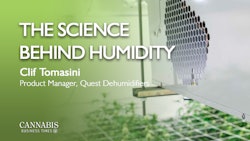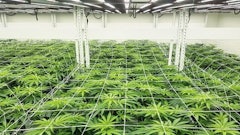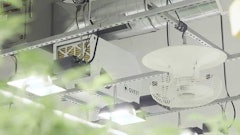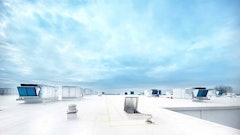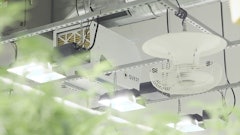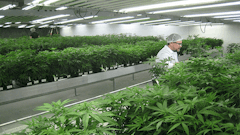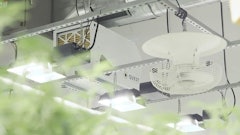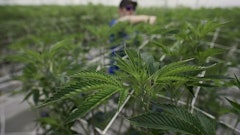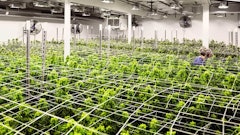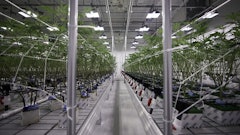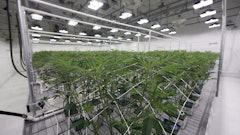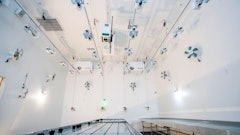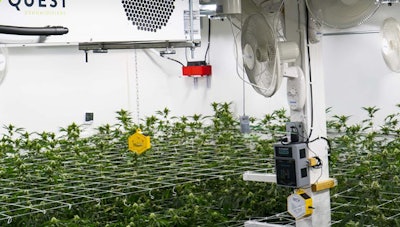
Keeping powdery mildew and other pests out of a grow is already difficult with employees working around the plants. A major factor in making sure that any mold or disease that finds its way in won’t find what it needs to grow is tightly controlled humidity.
Aaron Newsom, COO at the Santa Cruz Veterans Alliance in Santa Cruz, Calif., uses a dehumidification system to keep his medical cultivation site’s humidity in the right range to protect his plants.
With a 12,000-square-foot indoor sealed-room facility, Newsom uses dehumidifiers to regulate the grow conditions to “create an optimal environment for plant growth,” he says.
“If we didn’t have the dehumidifiers, we’d probably be pushing 80 to 90 percent humidity,” he says. “Controlling the environment is key, and creating that environment is 100 percent of my job. The dehumidifiers play a huge role in that, because they help create that perfect environment here in the warehouse.”
Building that environment isn’t only about giving the plant the best surroundings for growth. It’s also about making sure other elements never have the chance to even get started growing, he says.
“Preventive maintenance is what needs to be implemented in this kind of operation,” says Newsom. “We’re completely preventive all the time. We’re always taking proactive steps to create a situation where molds cannot accumulate, so we don’t get powdery mildew or root rot. We really try to stay on top of it, so we just don’t have to deal with that.”
Avoiding the problem entirely by being conscientious of keeping employees from tracking in mold and maintaining an environment that checks its growth takes effort. But it’s easier than having to go through all the cleaning procedures if there is contamination.
“It’s such a nightmare … to just stay … preventive,” says Newsom. “That’s a preventive measure to create an optimal environment just like watching temperature or CO2 inoculation, or using different types of integrated pest management.”
Newsom and his business partner worked with Quest Dehumidifiers to determine what kind of dehumidification system they needed for their grow, and decided on a Quest Dry 155 for each grow room. Deciding which machine they needed to reach their control goals wasn’t difficult, though, according to Newsom.
“We contacted the company and worked with what they recommended. I think a lot of people in this industry think there’s secret recipes or secret ways to use equipment, but we’re just growing plants,” he says. “As much in the way of technical information and assistance I can get from the companies that make specific equipment, the better. Talk to the reps, and they’ll point you in the right direction. They don’t want you to fail either.”
For his current grow, he’s working with a dehumidification system that runs separately from his other HVAC setup. That gives him redundancy to work with if one part of the dehumidification system goes out, or his HVAC fails for any reason. But running multiple, separate systems means more parts that can break or need servicing, so keeping the cultivation running smoothly means relying on the company to service or repair parts quickly, he says.
“It really depends on the company itself and your relationship with them,” he says. “You need to know if they’re good at customer service, whether they’re in it for the quick buck or for the long run.”
When it comes to testing new parts or products, Newsom uses one of his grow rooms for product testing. He checks plant data after a harvest, and makes a decision as to whether to expand the usage or go back to the prior setup. “Sometimes you need to play it by ear to see how equipment works,” says Newsom. Cultivators are growing plants like in any other greenhouse, but “there’s no blueprint out there for [growing cannabis]. Sometimes it’s individual trial and error.”
For Newsom, that makes it even more important to have as much control over the humidity in his cultivation as possible, he says, and to stay on ahead of any kind of mildew or mold before it becomes a threat.
“Those are really the two things I can’t stress enough: preventive maintenance and environmental control,” he says. “Be preventive. Make sure you have the proper cultural and humidity controls, cleanliness, sanitation and different entrance/exit protocols. Then you don’t have to deal with pests like molds and mildew.”
Aaron Newsom, COO at the Santa Cruz Veterans Alliance in Santa Cruz, Calif., uses a dehumidification system to keep his medical cultivation site’s humidity in the right range to protect his plants.
With a 12,000-square-foot indoor sealed-room facility, Newsom uses dehumidifiers to regulate the grow conditions to “create an optimal environment for plant growth,” he says.
“If we didn’t have the dehumidifiers, we’d probably be pushing 80 to 90 percent humidity,” he says. “Controlling the environment is key, and creating that environment is 100 percent of my job. The dehumidifiers play a huge role in that, because they help create that perfect environment here in the warehouse.”
Building that environment isn’t only about giving the plant the best surroundings for growth. It’s also about making sure other elements never have the chance to even get started growing, he says.
“Preventive maintenance is what needs to be implemented in this kind of operation,” says Newsom. “We’re completely preventive all the time. We’re always taking proactive steps to create a situation where molds cannot accumulate, so we don’t get powdery mildew or root rot. We really try to stay on top of it, so we just don’t have to deal with that.”
Avoiding the problem entirely by being conscientious of keeping employees from tracking in mold and maintaining an environment that checks its growth takes effort. But it’s easier than having to go through all the cleaning procedures if there is contamination.
“It’s such a nightmare … to just stay … preventive,” says Newsom. “That’s a preventive measure to create an optimal environment just like watching temperature or CO2 inoculation, or using different types of integrated pest management.”
Newsom and his business partner worked with Quest Dehumidifiers to determine what kind of dehumidification system they needed for their grow, and decided on a Quest Dry 155 for each grow room. Deciding which machine they needed to reach their control goals wasn’t difficult, though, according to Newsom.
“We contacted the company and worked with what they recommended. I think a lot of people in this industry think there’s secret recipes or secret ways to use equipment, but we’re just growing plants,” he says. “As much in the way of technical information and assistance I can get from the companies that make specific equipment, the better. Talk to the reps, and they’ll point you in the right direction. They don’t want you to fail either.”
For his current grow, he’s working with a dehumidification system that runs separately from his other HVAC setup. That gives him redundancy to work with if one part of the dehumidification system goes out, or his HVAC fails for any reason. But running multiple, separate systems means more parts that can break or need servicing, so keeping the cultivation running smoothly means relying on the company to service or repair parts quickly, he says.
“It really depends on the company itself and your relationship with them,” he says. “You need to know if they’re good at customer service, whether they’re in it for the quick buck or for the long run.”
When it comes to testing new parts or products, Newsom uses one of his grow rooms for product testing. He checks plant data after a harvest, and makes a decision as to whether to expand the usage or go back to the prior setup. “Sometimes you need to play it by ear to see how equipment works,” says Newsom. Cultivators are growing plants like in any other greenhouse, but “there’s no blueprint out there for [growing cannabis]. Sometimes it’s individual trial and error.”
For Newsom, that makes it even more important to have as much control over the humidity in his cultivation as possible, he says, and to stay on ahead of any kind of mildew or mold before it becomes a threat.
“Those are really the two things I can’t stress enough: preventive maintenance and environmental control,” he says. “Be preventive. Make sure you have the proper cultural and humidity controls, cleanliness, sanitation and different entrance/exit protocols. Then you don’t have to deal with pests like molds and mildew.”







